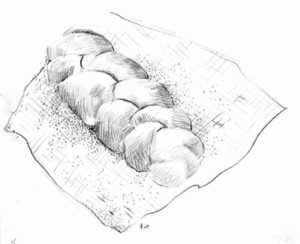 |
| Toki Oshima drawing |
By Grace Oedel
Bread occupies a unique and highly sanctified place in many religious traditions. In Judaism, the ritual laws surrounding bread stand apart from all other culinary rituals. A meal is defined by whether or not you consumed bread. If you did, you are mandated to carry out a full set of prayers before and after the meal. If you have munched on most other snacks, you are only required to utter a quick couple of lines. Bread mandates meaningful time and prayer investment. Bread slows your spiritual pace.
The very content of the prayer for bread diverges from the typical pattern as well. Most Jewish prayers for food focus on the growth pattern of the crop. For example, the blessing for wine essentially reads, “Thanks to God, who brings forth fruit from the vine.” When chowing french fries, we might offer up a similarly phrased prayer for potatoes: “Thanks to God, who brings forth fruit from the earth.” How the primary ingredient grew – potatoes in the ground, grapes on the vine – provides the central element of the blessing. Moments of spiritual thanksgiving connect people with agricultural knowledge. In order to pray correctly, you most understand how food grows.
The prayer for bread, however, takes a different form, and with it a different meaning. The prayer for bread reads, “Blessed is God who brings forth bread from the earth.” Bread arises from the earth fully formed in its final state, “brought forth” – baked up by the divine. Bread is so fundamental a component of life that it is seen as being an elemental ingredient itself. Shabbat, the day of rest, is the most holy time of the week. What pulses at the heart of this sacred day? Challah, braided bread. (It’s worth noting that many religious traditions enjoy braided, egg-heavy breads during spring holidays – think about Easter bread and King Cake!)
Bread offers us perennial spiritual nourishment; it sanctifies time; it draws us closer to the divine. In some sects of Christianity, the act of Holy Communion transforms the bread itself into divine body through a theological idea called ‘transubstantiation.’ Eating bread is quite literally eating God.
As someone who thinks about farming a great deal, however, I wonder how we can reconcile the holy role of bread with the decidedly profane environmental ramifications of large-scale conventional annual wheat farming. Growing wheat frequently calls for intensive tilling of the soil (resulting in loss of topsoil), dumping of synthetic fertilizers (which run off and cause enormous dead zones in oceans) and pesticides (which some scientists argue are linked to the rise in gluten intolerance and gut issues). How can such a farming practice that degrades the earth nourish us spiritually? Is there a better way to cultivate this important crop in harmony with its spiritual ethics?
Organic wheat production certainly offers a good starting point. MOFGA certified organic Songbird Farm offers a dry goods CSA that includes wheat. The farmers integrate cover crops for soil fertility and minimize tilling. Eli Rogosa runs the Heritage Grain Conservancy, an organization dedicated to stewarding ancient land races of grains, grown in truly sustainable ways that nourish earth and eater. Wes Jackson at the Land Institute in Kansas has been breeding a perennial wheat called Kernza for years that offers a potential to restore prairie-like, carbon-sinking, perennial methods of wheat cultivation.
Bread has signified spiritual nourishment and connection to God for thousands of years. I am inspired by those farmers taking up the challenge of healing the way we grow this crucial crop, leading us to grow wheat with as much sanctity as we break bread.
About the author: Grace Oedel runs an educational farm in Shutesbury, Massachusetts, Dig In Farm, with her husband, Jacob Holzberg-Pill. Dig In Farm’s first project is Spiral, a residential summer permaculture program for young women: www.diginfarm.com/spiral.

